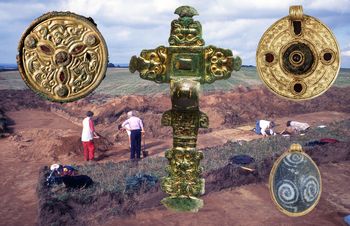Digital Data from the Excavation of Sawcliffe 'Sheffield's Hill' Anglo-Saxon cemeteries, North Lincolnshire, 1993-1996
Kevin Leahy, 2023. https://doi.org/10.5284/1112993. How to cite using this DOI
Data copyright © Kevin Leahy unless otherwise stated
This work is licensed under a Creative Commons Attribution 4.0 International License.
Primary contact
Kevin
Leahy
Brigg
Lincolnshire
Resource identifiers
- ADS Collection: 5971
- DOI:https://doi.org/10.5284/1112993
- How to cite using this DOI
Introduction

This collection comprises a database, images, and GIS data relating to the excavation of the Sawcliffe 'Sheffield's Hill' Anglo-Saxon cemeteries, North Lincolnshire. This resource catalogues the finds and spatial data from the excavation of two, adjacent, Anglo-Saxon cemeteries, Sawcliffe I, of sixth century date, and Sawcliffe II, dating to the seventh century. They were on the crest of the north-south escarpment of Lincoln Edge, 9km south of the Humber and in the parish of Roxby-cum-Risby, North Lincolnshire, SE 909154. They were discovered by metal detector users in 1992 and were in the process of being destroyed by ploughing and the erosion of the sandy soil. Seventh century finds suggested that the site had great potential and should be recorded. Fortunately, the North Lincolnshire Museum had the capacity to carry out an excavation and, with the aid of volunteers working under the direction of the Museum's Kevin Leahy and David Williams, the site was fully excavated between 1993 and 1996.
Acidic ground conditions led to the loss of much of the skeletal material but Dr Kirsty Squires was able to report on what survived. Many of the graves contained stains forming 'pseudomorphs' which allowed the positions of the bodies to be recorded. The grave goods had also suffered from the acid environment but conservators at the York Archaeological Trust were able to recover large amounts of information following the block-lifting of the grave groups. Of particular interest were the textiles the traces of which were well preserved and offer great potential.
Paired cemeteries are a well-known phenomenon in Early Anglo-Saxon archaeology, what is unusual at Sawcliffe is that the two cemeteries were only 20m apart with an almost complete segregation of the two phases of burial. Two seventh century graves were found in Sawcliffe I, the sixth century cemetery, no sixth century graves were found in Sawcliffe II providing a solid measure of what had changed.
Sawcliffe I was, in the main, a typical sixth century cemetery. It contained 53 graves including two cremations. There were some interesting burials, two graves had been surrounded by close-set ditches and a shield boss in Grave 115 bore signs of battle damage. There were no early burials: it is likely that these had would have been represented by the lost Bagmoor cremation cemetery 1.8km to the north.
Sawcliffe II contained 74 graves belonging to seventh century 'Final Phase' or 'Conversion Period'. These follow the expected pattern for these cemeteries; the graves were more strictly orientated than in Sawcliffe I and laid in rough rows. A great change had taken place in the grave goods; the large brooches, massed beads and sleeve-clasps that characterised the sixth century were gone, to be replaced by more restrained female dress. Most of the graves could be dated by the associated grave goods. Four graves contained gold and garnet jewellery and two held swords. Some aspects of Sawcliffe II contradicted the Conversion Period model: the proportion of graves containing no furnishings, or only a knife, is supposed to be high - at Sawcliffe II, 84% of the graves were furnished and contained an average of 3.2 types of find. This was a rich cemetery. The number of weapon burials, at 13.5% is remarkably high for the Conversion Period and there was one, un-urned cremation burial (Grave 113). The possibility of making direct comparisons between these two cemeteries offers an opportunity to look at this time of change.
Deposition of the digital archive was aided by funding from the Council for British Archaeology - East Midlands. The finds and excavation archive are deposited at the North Lincolnshire Museum in Scunthorpe.




